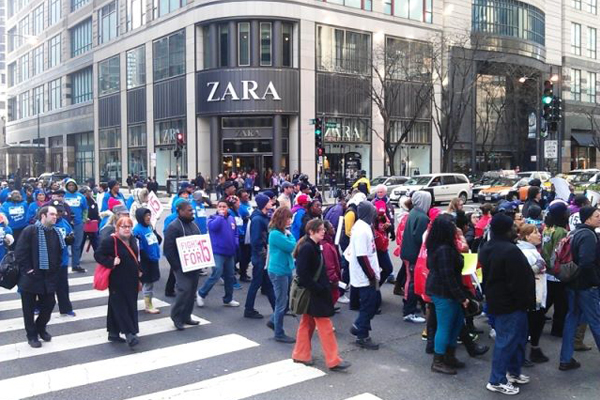
photo: micah uetricht
Fast food workers turning onto Michigan Ave during a protest just before 5 p.m. today.
Fast food employees put down their spatulas and hit the Chicago streets early this morning as part of a planned, and rare, low-wage work stoppage.
The rolling walk-out, which started at 5:30 a.m. and culminated this afternoon at the St. James Cathedral in River North, was organized by “Fight for 15,” a coalition that is demanding raises to $15 per hour for low-skilled workers employed downtown, along with the chance to form a union “without intimidation.” A similar campaign sprouted up in New York City this fall.
Labor reporter Josh Eidelson adds more context for Salon, and @micahuetricht has been following the march all day. Liberal political site Think Progress explains why the activists’ focus has turned to this sector of the economy, one in which labor unions have struggled to make inroads:
Fast food and retail jobs make up large portions of the low-wage sector that has grown rapidly since the Great Recession—though low-wage jobs made up just 21 percent of jobs lost during the recession, they account for 58 percent of the jobs added since it ended. Those job gains have come with big profits for companies like McDonalds, which has seen its profits rise 130 percent in the last three years. But workers, including an increasing number of college graduates, haven’t shared in that prosperity. They are making at or near the minimum wage, and they are increasingly doing so without benefits like health care and retirement plans. Low-wage workers have also found it hard to organize unions without retaliation from their employers.
The push comes on the heels of President Obama’s call, in his State of the Union speech this year, for a $1.75-per-hour federal minimum wage increase. Gov. Pat Quinn took a similarly populist stand in his State of the State, asking the General Assembly to bump the floor up to $10 per hour. The federal minimum wage is currently set at $7.25. Illinois’s rate, as of January 1, is $8.25 per hour. That's actually the fourth-highest in the nation. There are roughly 400,000 minimum wage workers in the state.
A bill called SB 68, currently stalled in the state Senate, would increase Illinois’ minimum wage by $0.50, plus an additional amount equal to the increase in the cost of living during the preceding year. Ultimately, the minimum wage would be restored to “its historic level,” which the proposal considers "the inflation adjusted equivalent of $1.60 per hour in 1968.” (It’d be roughly $10.68 per hour, all told.)
Many unions, community groups, and workers rights organizations are in favor, while the Illinois Retail Merchants Association opposes. In 2010, when I was writing for the left-leaning news site Progress Illinois, I tried to tackle some of the arguments against a minimum wage hike, namely that it leads to large-scale job losses and drags down the local economy. The reliably liberal Sun-Times editorial board, meanwhile, argued against SB 68 earlier this month, claiming it would "send jobs over the border or into oblivion."
Several Republicans in the General Assembly, meanwhile, held press conferences in Decatur and Normal to promote changes they’d like to make to the Temporary Assistance for Needy Families, the state’s welfare-to-work program. Among them would be a requirement for all LINK cards to display a photo of the user. That's despite protests from the usually-friendly Merchant’s Association, which says “gas stations, grocery stores, local shops don’t want to deal with the headaches or possible legal nightmare that might be created by adding pictures to LINK cards.”
The arguments in favor might be more convincing if House Minority Leader Tom Cross (R-Oswego) and his colleagues would provide some firm numbers (or even estimates) about how much fraud these programs actually attract. Their bills are basically dead on arrival—Rich Miller explains the legislative logistics here—so it’s probably not worth spending too much more time debating them.
Speaking of Miller, he excerpts a chart from a new report on the Illinois economy, produced by the Commission on Government Forecasting and Accountability, showing the current unemployment rate in each Illinois county. Cook County, at 10.5 percent, has it bad. But we're not in nearly as rough shape as some of our neighbors.


